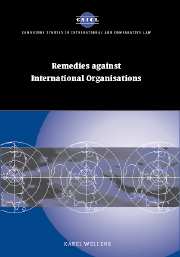Book contents
- Frontmatter
- Contents
- Acknowledgements
- List of abbreviations
- Introduction
- Part I General features of remedies against international organisations
- Part II Procedural aspects of remedial action against international organisations
- 7 Introduction to procedural aspects of remedial action against international organisations
- 8 Procedural aspects of remedial action by member states
- 9 Procedural aspects of remedial action by staff members
- 10 Procedural aspects of remedial action by private claimants
- 11 Procedural obstacles for representational non-governmental organisations
- 12 Procedural obstacles common to remedial action by non-state claimants
- Part III Substantive outcome of remedial action against international organisations
- Part IV Alternative remedial action against international organisations and options for the future
- Conclusion
- Bibliography
- Index
- CAMBRIDGE STUDIES IN INTERNATIONAL AND COMPARATIVE LAW
9 - Procedural aspects of remedial action by staff members
Published online by Cambridge University Press: 13 July 2009
- Frontmatter
- Contents
- Acknowledgements
- List of abbreviations
- Introduction
- Part I General features of remedies against international organisations
- Part II Procedural aspects of remedial action against international organisations
- 7 Introduction to procedural aspects of remedial action against international organisations
- 8 Procedural aspects of remedial action by member states
- 9 Procedural aspects of remedial action by staff members
- 10 Procedural aspects of remedial action by private claimants
- 11 Procedural obstacles for representational non-governmental organisations
- 12 Procedural obstacles common to remedial action by non-state claimants
- Part III Substantive outcome of remedial action against international organisations
- Part IV Alternative remedial action against international organisations and options for the future
- Conclusion
- Bibliography
- Index
- CAMBRIDGE STUDIES IN INTERNATIONAL AND COMPARATIVE LAW
Summary
The present system of protection
In its Resolution 47/226, adopted on 8 April 1993, the UN General Assembly stressed the importance of a just, transparent, simple, impartial and efficient system of internal justice at the Secretariat and requested the Secretary-General to undertake a comprehensive review of the UN system for the administration of justice. A task-force not only proposed a complete reform of the administrative review system, but also called for measures to encourage settlement through informal channels, such as through the office of an ombudsman. This issue is dealt with in Part IV of this study.
Given their special position under the internal law of the organisation, and also because of their contractual relationship with the organisation, it is not surprising that staff members have submitted, and will certainly continue to submit, the largest majority of claims against international organisations originating from private parties. Although most of these claims are of a contractual nature, there is no reason to exclude tortious liability as a matter of principle or otherwise. The challenge to the legality of decisions may be based on incompetence, procedural irregularity, abuse of power or violation of applicable statutes or institutionalised rules, as in most domestic forms of administrative review.
One of the reasons why international organisations establish their own settlement machinery to deal with employment-related disputes between the organisation and staff members is that otherwise ‘national courts could be induced to assume jurisdiction in such cases’.
- Type
- Chapter
- Information
- Remedies against International Organisations , pp. 81 - 87Publisher: Cambridge University PressPrint publication year: 2002



